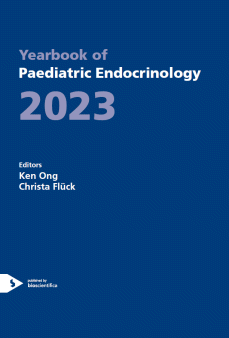ey0020.14-1 | Section | ESPEYB20
14.1. Energy trade-off and 4 extreme human body types
Hochberg Ze'ev , Albertsson-Wikland Kerstin , Prive Florian , German Alina , Holmgren Anton , Rubin Lisa , Shmoish Michael
ey0020.14-2 | Section | ESPEYB20
14.2. Prediction of adult height by machine learning technique
Shmoish Michael , German Alina , Devir Nurit , Hecht Anna , Butler Gary , Niklasson Aimon , Albertsson-Wikland Kerstin , Hochberg Ze'ev
ey0020.14-3 | Section | ESPEYB20
14.3. People are taller in countries with better environmental conditions
A German , G Mesch , Z Hochberg
ey0020.14-4 | Section | ESPEYB20
14.4. Steroid metabolomic signature of insulin resistance in childhood obesity
AM Gawlik , M Shmoish , MF Hartmann , SA Wudy , Z Hochberg
ey0020.14-5 | Section | ESPEYB20
14.5. Emerging adulthood, a pre-adult life-history stage
ey0020.14-6 | Section | ESPEYB20
14.6. Outcomes of pubertal development in girls as a function of pubertal onset age
A German , M Shmoish , J Belsky , Z Hochberg
ey0020.14-7 | Section | ESPEYB20
14.7. Early adiposity rebound and premature adrenarche
Marakaki Chrisanthi , Karapanou Olga , Gryparis Alexandros , Hochberg Ze'ev , Chrousos George , Papadimitriou Anastasios
ey0020.14-8 | Section | ESPEYB20
14.8. Child health, developmental plasticity, and epigenetic programming
Z Hochberg , R Feil , M Constancia , M Fraga , C Junien , JC Carel , P Boileau , Y Le Bouc , CL Deal , K Lillycrop , R Scharfmann , A Sheppard , M Skinner , M Szyf , RA Waterland , DJ Waxman , E Whitelaw , K Ong , K Albertsson-Wikland
ey0020.14-9 | Section | ESPEYB20
14.9. Juvenility in the context of life history theory
ey0020.14-10 | Section | ESPEYB20
14.10. The importance of adrenocortical glucocorticoids for adrenomedullary and physiological response to stress: A study in isolated glucocorticoid deficiency
Zuckerman-Levin Nehama , Tiosano Dov , Eisenhofer Graeme , Bornstein Stefan , Hochberg Ze'ev
ey0020.14-11 | Section | ESPEYB20
14.11. Effect of thyroid hormone and growth hormone on recovery from hypothyroidism of epiphyseal growth plate cartilage and its adjacent bone
D Lewinson , Z Harel , P Shenzer , M Silbermann , Z Hochberg
ey0020.14-12 | Section | ESPEYB20
14.12. The effect of single-dose radiation on cell survival and growth hormone secretion by rat anterior pituitary cells
Z Hochberg , A Kuten , P Hertz , M Tatcher , A Kedar , A Benderly




